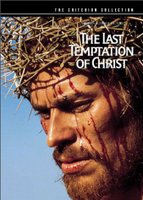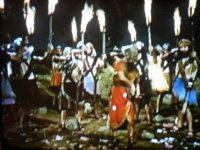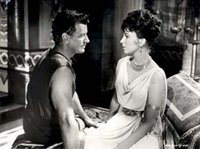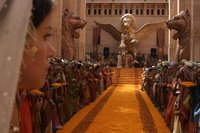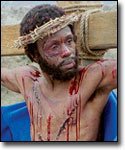The Early Jesus Film Synoptic Problem
I won a DVD of "Early Religious Films" on eBay, and they arrived yesterday (in less than a week - from Canada). The information on the auction page claimed that it contained 3 films from the 1890s and 1900s, Life of Christ, Death of Christ, and David and Saul. Information about this period in cinema history is fairly unreliable so I was fairly sceptical as to what it might produce.
Having watched both of the Jesus films I'm still not sure what to make of them. I'm going to discuss each film individually as we go through the week. The hardest task before me however is trying to work out the date of these films.
Before the internet, there were two major sources of reference information on Films about Jesus, "Divine Images" by Roy Kinnard and Tim Davis, and "The Bible on Film: A Checklist 1897-1980" by Richard H. Campbell and Michael R. Pitts. However, neither of these films mention a Jesus film, made by Pathé before The Life and Passion of Jesus Christ, listed as 1905. The opening shot of this film is shown below:
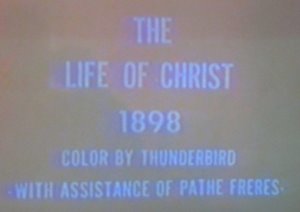
It seems unlikely that this might have been faked, particularly as it appears that all three films appear on a video entitled "A History of Color in Silent Films" which covers Pathé films from 1898 onwards, and The Life of Christ is the first.
A third piece of the puzzle is the relationship between this film and The Life and Passion of Jesus Christ. This film was given a wide release on DVD a few years ago, and the packaging claimed parts of it were released in 1902 with extra scenes and colouring being added with subsequent re-releases in he years up to 1905. This contradicts the testimonies of both both "The Bible on Film", and "Divine Images". Both of which list Pathé's first film of this title being released in 1905 and another longer film of the same title being released in 1908, with a colourised version being produced in 1914, when reviewers, who were seemingly unaware of its antiquity, slated it for poor production.
The relevance of this becomes apparent from the first scene of The Life of Christ which is identical to a scene in The Life and Passion, in fact, as the film continues, it appears that most of The Life of Christ was reproduced in The Life and Passion of Jesus Christ. Something of a Jesus film synoptic problem. That said there are some scenes which are different - either the same scene shot very differently, or similarly but in a different location, or with different actors, whereas some are entirely absent in The Life and Passion of Jesus Christ. Other scenes are less extravagantly coloured than the ones from that film. Significantly all of the scenes that look like they have been re-shot are significantly better in The Life and Passion of Jesus Christ.
On the other hand, most of the material from The Death of Christ is original, although even it utilises some of the same material that is later incorporated into The Life and Passion of Jesus Christ. Here though the quality of the film (from an aesthetic point of view) is lower, suggesting that this is the oldest of the three films. In several places where one of the later films improves upon one of the earlier two films, one of its "improvements" is to add special effects. For example the resurrection scene in "The Death of Christ", is less technical, but also far less gaudy than the way Jesus hovers out of the tomb in both of the later films.
 So the three films are clearly related, and it would be logical to suggest that The Death of Christ, is the eldest film (particularly given that most of the very first Jesus films were passion plays). However, things are not quite that simple. Firstly, it appears that a number of different actors are used in The Life of Christ. This and the fact that the style of the intertitles changes from those identical to The Life and Passion of Jesus Christ, to others that look older, and less sophisticated, suggests that this film (and possibly The Death of Christ) are composites.
So the three films are clearly related, and it would be logical to suggest that The Death of Christ, is the eldest film (particularly given that most of the very first Jesus films were passion plays). However, things are not quite that simple. Firstly, it appears that a number of different actors are used in The Life of Christ. This and the fact that the style of the intertitles changes from those identical to The Life and Passion of Jesus Christ, to others that look older, and less sophisticated, suggests that this film (and possibly The Death of Christ) are composites.
NT scholars will be relieved to hear that my hypothesis isn't that there was a fourth hypothetical Jesus film now lost which the two later films copied parts of and incorporated! My best guess is that the earliest parts of these films do date from 1898, but that the longer Life of Christ film didn't reach this hotch-potched form until 1902. It subsequently was expanded to 2 reels and tidied up a bit in 1905 and released as The Life and Passion of Jesus Christ, and similarly was expanded again to 3 reels in 1908 and re-released under the same title. This means that Campbell, Pitts, Kinnard and Davis come away with some credit, as do the packagers of the The Life and Passion of Jesus Christ, but none of them get things wholly correct. This leaves a number of gaps unfillled, not least the varying intertitles (which would be easier to fix and more noticeable than changing Jesus), and questions as to what point the film got hand coloured (the books say not until 1914, but all the other evidence points the other way).
If anyone knows more about these films, please do post some comments. Alternatively, if you would like to get hold of these films and decide for yourself The Life and Passion of Jesus Christ is widely available and I get the impression that the others will up on eBay again soon (or can be bought on VHS from the link above).
Matt
Labels: Life and Passion of Jesus Christ, Pathé, Silent Bible Film Mysteries, Silent Bible Films, Silent Jesus Films















